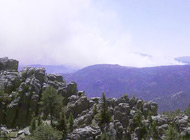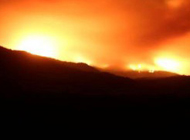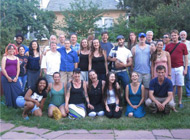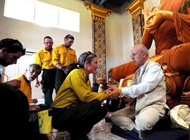The Smoky Start

The nearby town of Glacier View was put on notice around lunch time. Not long after, the staff of SMC was called together in the main shrine room of Sacred Studies hall. Shambhala Mountain Center with over 100 staff, volunteers and participants would evacuate within the hour to prevent blocking the country roads should the rest of the area’s population need to flee as well.
As we dispersed to gather one bag’s worth of clothing, essentials, and anything we could not bear to lose in the fire, the column of smoke rising over Marpa point had new immediacy. We said goodbye to most of our possessions and reconvened to arrange transport.
Riders gathered around drivers, a destination was agreed upon and recorded to make sure everyone was accounted for. A few stayed behind to protect and prepare. The majority of the close to 100 staff and volunteers went to Boulder where the large programs would occur and the rest went to Fort Collins to await further instruction. Thus began the 3-week experience that would test Shambhala Mountain Center’s resiliency as a community, a network of practitioners, and as a vessel of meritorious action and awareness in modern society.
SMC in Threes
The Shambhala Mountain Center is normally recognized as a physical location, some 600-acres in a valley of the Rocky Mountains, about an hour’s drive west from Fort Collins. However, if one reality has been revealed by the evacuation, it is that Shambhala Mountain Center is the people who manifest it; be they staff members, former staff members, donors, or program participants.
Three distinct representations of SMC formed in Boulder, Fort Collins, and at the land center.
At Shambhala Mountain Center 12 staff members consisting of kasung and volunteer firefighters manifested warriorship in ways they could never have predicted. Full days began with morning meditation followed by maintenance chores and fire prevention initiatives.
Meanwhile the Boulder staff manifested service to proceed with the program schedule but away from home. They arranged transportation, housing, and program space. They worked long hours and extended themselves out of compassion for the efforts of others and practiced in groundlessness as obstacles arose and solutions were invented amid the spacious urban bustle of Boulder.
In Fort Collins other staff members and volunteers arrived to find a city bulging with refugees from the blaze, where the focus became practice-centered and communal. Practice became the locus of sanity, and through dedicated attention to the principles of mindfulness SMC retained its presence without its original container.
The Jewels Forged in Radical Shila
Service
In Boulder, the Sakyong requested that the SMC staff team up with the Boulder Shambhala Center to proceed with the summer programs so that essential teachings could be transmitted and the paths of many Shambhalians would not be hindered. No one among the transplanted staff knew how this would happen—there were no emergency instructions tucked inside a binder for the occasion. Boulder was large, and unlike Fort Collins was relatively oblivious to the fire’s effects, so it took effort to maintain the interpersonal connections that constituted the community. There were regular check-ins, meetings at Marpa house, and spontaneous gatherings.
Lisa Hill, who has since returned to SMC to direct the community life, recalled that her impression from that time was about the volunteers. “I have complete devotion to this lineage. I made vows to the Sakyong. But many of these volunteers had only recently begun their path or had only a casual commitment to SMC.” Or so it seemed. The reality was that no one wanted to bail on the others. Lisa Hill has encountered as a social worker many populations of people in distress, and so she summarized this phenomenal camaraderie as “the shedding of ego in times of trouble”.
Warriorship
The problems of everyday life undermine our comfort and security, but for our firefighters and kasung (a practice that takes the military forms to work with mindfulness instead of aggression, at SMC this looks a lot like the Park Rangers) a raging fire brought on by historic droughts, wild winds, and the deadwood conflagrations thanks to a pine beetle epidemic absolutely destroyed the ego’s credentials. This was an unparalleled gift to their practice of warriorship, because when there is no panic in dealing with emotions, they can be dealt with completely and properly.
Adrenaline is necessary in dire situations, but it can also bring about a disconnect. So the kasung of SMC relied on several slogans to check themselves. “Take a break before you think you need it” was a practical one to prevent fatigue and collapse. “Look up, look down, look all around” inspired full awareness, an essential safety precaution since they needed to operate machinery in many of their tasks.
One kasung member, Jacob Taylor, described this test as the most profound experience he has ever had at SMC. It was like being on staff, attending Dathun (a month-long meditation retreat) and MPE (a training program in the meditations and teachings of kasung-ship) all at the same time. The kasung were obliged to use all of their training in the most critical of situations. The training that they had undergone with a serious view towards discipline, communications, responsibility, chain of command, and holding one’s seat was revealed to be intuitively connected to the ICS structure used in many emergency commands. By many accounts, ICS is the most functional government system, and combined with the view of kasung-ship the resulting structure allowed our firefighting staff to actually relax into their situation’s immediacy and simplicity.

Duties were divided between preparing for the arrival of the fire and preparing for the return of the evacuees. A morning might be spent digging ditches and cutting trees while an afternoon would be dedicated to tightening tents and cleaning up public spaces. The banality of the activities was thrown into relief by the dire implications of what they were preparing the ground for.
At times, this routine felt patently absurd. The cognitive dissonance came out in frustration at tents that might just as easily burn as be occupied, or worry as to whether cutting down a hundred year old pine was unnecessary because the fire would never arrive. They persevered by resting in the groundlessness of their situation through practice.
Practice
Our staff in Fort Collins was taken in by the Fort Collins Shambhala Center, where everyone met for daily practice. They stayed in the homes of area sangha members. Some members volunteered in local relief efforts or extended themselves individually to the people of Fort Collins. They provided space and acceptance to those under grave duress without pride and accepted assistance without shame.
The fire gifted many with the means of cutting through appearances. Looking imposes names, applies classification to the world. It invites reductive thinking strategies like good and bad. During the long days of anticipation, staff members learned to see instead of look. Seeing things means accepting what they are without the unnecessary effort of making sure that nothing is about to confuse your relationship with the world.
It has been said that there is no other way to reach the depths of meditation practice except through boredom. Fort Collins was alive with busyness but busyness can only distract, never assuage boredom. By making very close contact with the emotions and the war between emotions and self, the illusory divisions (me and my projections, me and the world outside) become transparent.


